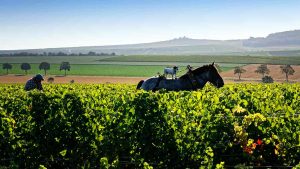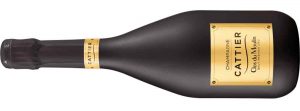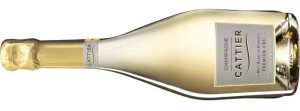To truly understand the history of Champagne Cattier one needs to delve into the history of the family that has been its driving force for 400 years. The founding blocks of this historical maison date back to 1625, when the Cattiers first started planting vines in Chigny-les-Roses, in the heart of the Montagne de Reims.
Alexandre Cattier is now the 13th generation at the helm of the company and winery (and the fourth to produce the house’s own champagne), having taken over from his father in 2011. He works alongside his cousins Agathe, Assistant Managing Director, and Marie, Brand Ambassador. In their hands now rests the privilege and responsibility of nurturing the legacy that was handed to them and that they will eventually pass on to a 14th generation.

Firmly grounded in a deep connection to the vines owned by the estate itself and the landscape where they sit, Cattier’s philosophy is first and foremost about a connection to the land, letting it shape the house style, rather than the other way around. Spanning across 33 hectares, the estate’s vineyards were planted and are still tended to by the family – a natural and cultural patrimony of unparalleled value in the context of Champagne. While these have now been granted HVE (Haute Valeur Environnementale) certification, such stamp merely formalised the sustainable working practices that were consistently followed by Cattier.

This is what makes Cattier special: vocation as vignerons as much as winemakers; awareness of terroir as a driving force; commitment to identity and tradition, without giving in to passing trends; clarity in the pursuit of excellence.
In Alexandre’s words, it is his responsibility to commit to his duty as guardian of this legacy, through each vintage and in each cuvée.
Cattier is now distributed in the UK through Majestic, a ground-breaking partnership that makes these extremely special wines available to a wide audience of wine lovers.
“Champagne-lovers can look forward to trying something truly unique – with a product rooted in the history of the region, that really showcases why it’s worth spending a little more.” said Majestic’s Chief Commercial Officer, Rob Cooke.
Cattier – two flagship cuvées:
These two cuvées help understand the work, ethos and style of a Champagne house that has always, and consistently, strived to capture a sense of place, rooted in knowledge handed down through generations.
 Clos du Moulin Brut Premier Cru
Clos du Moulin Brut Premier Cru
A unique champagne: one plot, two varieties, three vintages
Available at Majestic for £99.99 (or £84.99 in a Mix Six)
Cattier’s Clos du Moulin is one of only two walled vineyards, or Clos, in existence in the early 20th century. In 1950, Jean Cattier purchased this reconstituted 2,2-hectare plot, much of which was little more than a battle-scarred wilderness with only a few remaining vines. After a year spent restoring the vineyard, the first grapes were harvested 1951 and fermented separately to create the first “Clos du Moulin” champagne, released in 1955.
The team at Cattier currently produce the Clos du Moulin by blending equal parts of Chardonnay and Pinot Noir, from three vintages selected for their potential to age with complexity and poise. It spends eight years on the lees before being disgorged and released. Each bottle has its own unique number.
 Brut Blanc de Blancs Premier Cru
Brut Blanc de Blancs Premier Cru
An icon in the making: character, power and elegance
Available at Majestic for £49.99 (or £39.99 in a Mix Six)
Made solely from the Cattier team’s nine favourite villages (mostly Ludes, Chigny-les-Roses and Rilly-la-Montagne), the Blanc de Blancs Premier Cru has become the house’s most iconic cuvée. Produced with 40% reserve wines, it spends four years on the lees and develops a character that distinctively differentiates it from other Blanc de Blancs, with finely weaved aromatic complexity, generous richness and, above all, a transparent expression of terroir.



 Clos du Moulin Brut Premier Cru
Clos du Moulin Brut Premier Cru Brut Blanc de Blancs Premier Cru
Brut Blanc de Blancs Premier Cru



